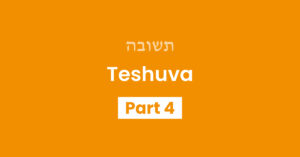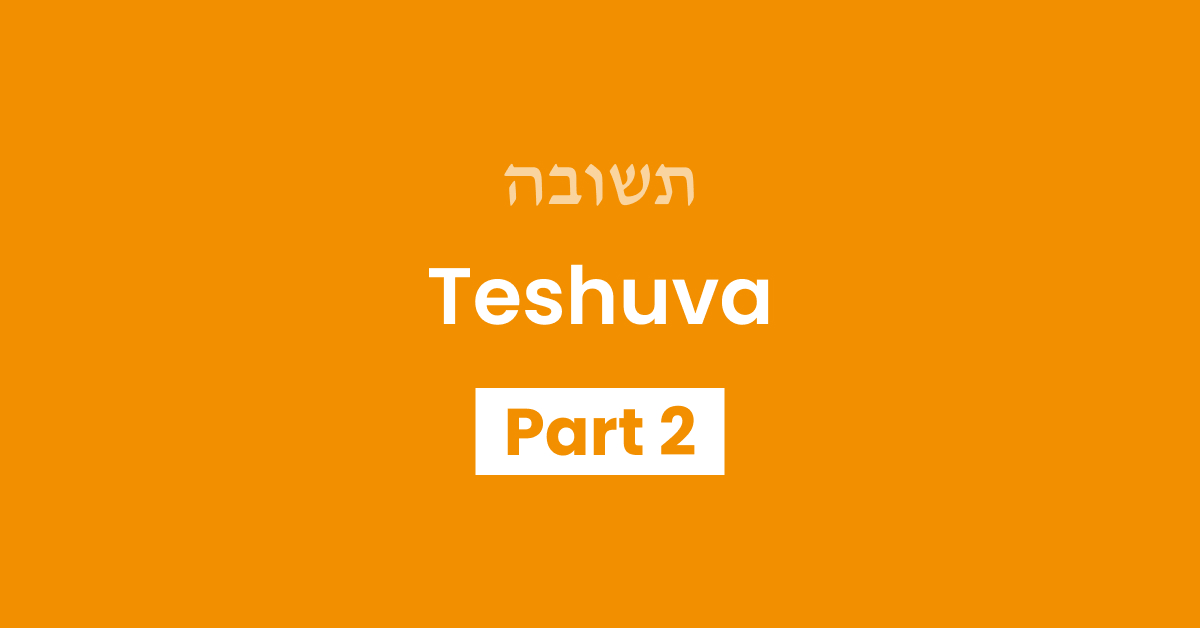We are nearly halfway through the month of Elul, and Rosh Hashana is just a few short weeks away. So far this month, we have been discussing some concepts related to Teshuva. First, we said that the first step of Teshuva is making a Cheshbon HaNefesh – making an accounting to see which of your deeds are bringing “profits” for your soul, and which ones are causing your soul to incur “losses.”
Next, we outlined the 3 basic steps of Teshuva, and considered how Azivas HaCheit – resolving never to repeat a sin again – is often the hardest step of all 3. But even if we are not yet able to do a full Azivas HaCheit – committing to never repeat the same sin again – we can still utilize the special power of this month of Elul by changing our behaviors as much as we can… even if it turns out to be only temporary. Elul is the time for “active” teshuva – changing our external actions – and Tishrei will be the time for using Hashem’s special tools (eg. the shofar and the 13 Middos) to achieve Hashem’s final forgiveness.
Flipping It Around
Although there are only 3 basic steps in Teshuva (Vidui, Charata, and Azivas HaCheit), the sefarim write that there are still more things we can do to deepen our Teshuva and rectify the stains we have made on our souls.
As the Midrash1 says: “If a person has committed bundles of sins, he should counteract these sins by doing bundles of mitzvos: Feet that ran to do a sin should now run to do a mitzvah. A mouth that spoke falsehood should now speak truth and wisdom. Hands that shed innocent blood should now be opened to give charity to the poor. Eyes that were raised upward in haughtiness and pride should now be lowered in humility. A heart that ruminated over sinful thoughts should now instead contemplate words of Torah.”
In other words, whenever we notice that we have used our body to sin, we should identify the limb that we used to sin, and then try to use that same limb for doing a mitzvah.2
We should identify the limb that we used to sin, and then try to use that same limb for doing a mitzvah.
If we used our eyes for looking at inappropriate sights, we should use those same eyes for looking at words of Torah. If we used our mouth to speak angry words or lashon hara, we should now use our mouth for saying compliments or words of encouragement. If we used our hands for moving muktzeh items on Shabbos, we should now use those same hands for cooking or cleaning for Shabbos, or wearing tefillin.
Making a Deep Impact
Why is this a deeper way of doing Teshuva? Why isn’t it enough to just stop doing the sin we were doing before?
We can understand this based on what is written in the sefarim3, that every one of our physical body parts has a spiritual counterpart that exists in the spiritual realm. Hashem created every one of our nerves, limbs, cells, and muscles, and bones for the purpose of us fulfilling mitzvos. Whenever we use a limb for a doing a sin, that limb has failed to accomplish its purpose, and the spiritual counterpart of the limb becomes corrupted. But if after doing a sin, we use that same limb for doing a mitzvah, then the limb is now fulfilling its purpose and is now elevated to a higher level.
The limb is now fulfilling its purpose and is now elevated to a higher level.
Interestingly, the Chovos HaLevavos4 writes that this concept of doing Teshuva with the same limb is actually something that applies to our hearts and minds as well. If we sin with our hearts or minds – dwelling on thoughts of revenge, jealousy, or hatred of others – we can rectify these sins by using our hearts and minds for good purposes – loving other people, forgiving them, or focusing on thoughts of Ahavas Hashem or Yiras Shamayim.
This week, lets try to accomplish this deeper level of Teshuva by using our our limbs for mitzvos instead of aveiros. Let us hope that our efforts to improve our actions will bring about a deep and lasting change on our neshamos and bring us closer to Hashem.
Sources: [1] Vayikra Rabbah 21 5; [2] Orchos Tzaddikim: Shaar HaTeshuva; [3] see Reikanti on Parshas Nasso; [4] Chovos HaLevavos: Shaar HaTeshuva: Chapter 9;
Your Challenge
Once a day, think of something wrong you have done in the past, and which body part was used to sin. Then use that same limb for doing a mitzvah.
FOR EXAMPLE:
- If you let your eyes look at inappropriate sights, use your eyes for looking at divrei Torah.
- If you used your mouth to speak angry words or lashon hara, use your mouth to say compliments or words of encouragement.
- If you used your hands for moving muktzeh items on Shabbso, use your hands for preparing for Shabbos or wearing tefillin.
- If you used your heart to ruminate on thoughts of anger and revenge, use your hearts to think about some reasons why we can love Hashem.
Torah Questions
- After which sin does it say that the Jewish people mourned and refrained from wearing jewelry? (See Shemos 33:4)
- King Achav once killed a man naved Navos, in order to sneakily acquire his field. But then Eliyahu HaNavi came and warned him that Hashem was going to punish Achav for his actions. Achav took this warning to heart, and he did teshuva. What were some of the actions that King Achav did to show his remorse? (See Melachim I Chapter 21)
- Fill in the blank: “The evil person will leave his [evil ways], and the sinner will forsake his [sinful] thoughts, and return to Hashem, and Hashem our G-d will have mercy on him, because ________?” (Yeshaya 55:7)
- In Devarim 31:17, it says that if terrible tragedies happen to the Jewish people, they will realize that all these bad things are happening because _______?
- According to Rabbi Shmuel in the Gemara (Yoma 86b), what is one benefit of doing teshuva?
Questions to Ponder
- In Pirkei Avos (2:10), Rabbi Eliezer says a bunch of seemingly unrelated statements: “Respect your friends as much as you respect yourself; do not become angry easily; do teshuva on the day before you die, etc.” Is there a common denominator between all the points that Rabbi Eliezer said at the same time?
- The Gemara (Yoma 86b) writes that if a person does teshuva out of fear, his intentional sins will be transformed into accidental sins. But if he does teshuva on a higher level – motivated by love of Hashem – then his intentional sins will be transformed into merits. How can this be? If a person did a terrible sin, how can it be that Hashem would ever allow them to consider that a merit? Why not just erase the sin and go back to zero?
- The Gemara (Brachos 17a) says that the essence of Torah is that it should be accompanied by teshuva and good deeds. Isn’t this obvious? What is the Gemara trying to teach us?





